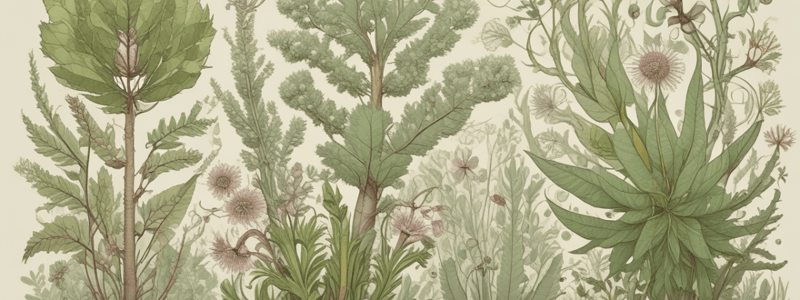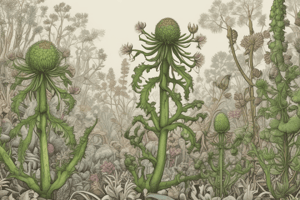Podcast
Questions and Answers
What is unique about the way mosses reproduce?
What is unique about the way mosses reproduce?
- They produce flowers and seeds
- They reproduce sexually and asexually (correct)
- They only reproduce sexually
- They only reproduce asexually
What is the function of the archegonium in a mature female moss?
What is the function of the archegonium in a mature female moss?
- It holds the male gametes
- It holds the female gametes (correct)
- It produces flowers
- It produces the sporophyte structure
What is the term for the change between haploid and diploid stages in mosses?
What is the term for the change between haploid and diploid stages in mosses?
- Alternation of plant stages
- Alternation of life cycles
- Alternation of generations (correct)
- Alternation of reproduction
What is the main difference between the haploid and diploid stages in the life cycle of mosses?
What is the main difference between the haploid and diploid stages in the life cycle of mosses?
What is the role of the sporophyte structure in mosses?
What is the role of the sporophyte structure in mosses?
What is the process by which the zygote undergoes DNA replication and splits to form identical cells?
What is the process by which the zygote undergoes DNA replication and splits to form identical cells?
What is the characteristic of mosses that distinguishes them from other plants?
What is the characteristic of mosses that distinguishes them from other plants?
What is the term used to describe the change between the gametophyte and sporophyte stages in the life cycle of mosses?
What is the term used to describe the change between the gametophyte and sporophyte stages in the life cycle of mosses?
What is the term used to represent the single set of chromosomes in the gametophyte stage?
What is the term used to represent the single set of chromosomes in the gametophyte stage?
What is the type of plant that includes mosses, liverworts, and hornworts?
What is the type of plant that includes mosses, liverworts, and hornworts?
What is the purpose of the antheridial head in the moss life cycle?
What is the purpose of the antheridial head in the moss life cycle?
What is the role of the foot in the moss life cycle?
What is the role of the foot in the moss life cycle?
What is the term for the type of reproduction that occurs in the sporophyte stage of the moss life cycle?
What is the term for the type of reproduction that occurs in the sporophyte stage of the moss life cycle?
What is the dominant phase of the moss life cycle?
What is the dominant phase of the moss life cycle?
What is the term for the process by which the zygote splits into two identical cells during the sporophyte stage of the moss life cycle?
What is the term for the process by which the zygote splits into two identical cells during the sporophyte stage of the moss life cycle?
Flashcards are hidden until you start studying
Study Notes
Moss Life Cycle
- Mosses are non-vascular plants belonging to Phylum Bryophyta, living in moist environments.
- They have two life stages: haploid and diploid, both multicellular.
- Haploid has male and female plants, reproducing sexually, while diploid has only one sporangium, reproducing asexually.
- This change between haploid and diploid is known as the alternation of generations.
- Mature moss plants, or gametophytes, can be either male or female.
Gametophytes
- Mature females have archegonia, holding female gametes, reproductive organs, and the egg.
- Mature males have antheridia, holding male gametes, reproductive organs, and sperm.
- Gametophytes are part of the haploid life stage and occur at the top of the plant.
Sporophyte
- Sporophyte structure is responsible for asexual reproduction and the diploid part of the cycle.
- Sporophyte develops from a zygote, which undergoes mitosis, forming a sporangium.
- Inside the sporangium, meiosis takes place, producing four genetically diverse cells (spores).
Life Cycle Process
- The cycle starts with two separate gametophytes, male and female, sexually reproducing.
- Sperm meets an egg, resulting in a zygote, marking the beginning of the diploid phase.
- The zygote undergoes mitosis, forming a sporangium, which produces spores.
- Spores grow into new gametophytes, restarting the cycle.
Important Terms
- n: represents one set of chromosomes, often used to describe the haploid stage.
- 2n: represents two sets of chromosomes, often used to describe the diploid stage.
- Alternation of generations: the change between haploid and diploid stages in moss life cycle.
- Fusion: the process of sperm meeting an egg, resulting in a zygote.
- Meiosis: the process of producing genetically diverse cells (spores) in the sporophyte stage.
Moss Reproduction
- Moss reproduction involves two types: sexual and asexual.
- Sexual reproduction occurs in the gametophyte stage, involving male and female gametes.
- Asexual reproduction occurs in the sporophyte stage, involving only one plant.
Gametophyte vs Sporophyte
- Gametophyte: haploid, dominant, sexual reproduction, sperm and egg fusion.
- Sporophyte: diploid, recessive, asexual reproduction, meiosis and spore production.
Parts of Moss
- Antheridial head: holds the antheridium and eventually creates the sporangium.
- Antheridium: produces sperm.
- Archegonial head: produces eggs.
- Bud: small, germinated spores.
- Capsule: holds the spores.
- Calyptra: protection over a forming capsule.
- Early Embryo: pre-zygote cells, can be called germination or fusion.
- Egg/Archegonium: where fertilization takes place, the female gamete.
- Foot: helps to give nutrients to the sporophyte.
- Germinating spore: spores that have taken hold and will become new plants.
- Leaves: produce photosynthesis, collect water.
- Neck canal: route for sperm to travel for reproduction.
- Neck wall: creates the neck cavity.
- Operculum: breaks when spores are ready to leave and germinate.
- Protonema: hormones for new cellular growth.
- Rhizoids: specialized root-like structure, anchors the moss but does not absorb water like roots.
- Seta: helps transfer nutrients throughout the flower.
- Sperm/Antheridium: male gamete.
- Spores: type of reproduction from the sporophyte.
- Spore case: holds spores.
- Sporophyte: creates the spores.
- Venter: holds the egg.
- Venter wall: creates the venter cavity.
- Zygote: single-celled organism created after fusion of the egg and sperm.
Studying That Suits You
Use AI to generate personalized quizzes and flashcards to suit your learning preferences.





